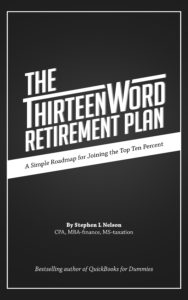 Over the last week, this blog has provided several posts related to this idea that you need a retirement plan “B” to deal with the very real possibility that you end up with less in your retirement savings than you expect… (The series started with this post: Retirement Plan B: Why You Need One.)
Over the last week, this blog has provided several posts related to this idea that you need a retirement plan “B” to deal with the very real possibility that you end up with less in your retirement savings than you expect… (The series started with this post: Retirement Plan B: Why You Need One.)
That message would be pretty, well, discouraging if you and I didn’t have any way to react ahead of time.
But fortunately we do. Specifically, you and I can employ a handful of tips to deal with this rather likely possibility.
And then, just to say this here, please please feel free to post any additional tips (as well as criticisms you see with the tips I’ve suggested).
This is serious business. Let’s come up with the best batch of tactics we can…
Tip #1: Avoid Denial
A first, simple tip: We want to avoid being in denial about this.
By admitting there’s a lot of potential variability in where we end up ultimately, we should be able to improve whatever outcome we do ultimately experience.
Tip #2: Quantify the Size of the Dilemma
Three blog posts this last week describe how to use the popular FIRECalc, cFIREsim and Portfolio Visualizer financial calculators to size up how bad any shortfall will be. I think one ought to use all three tools to gain insight.
Using all three tools should also provide a way to double-check your math. (The FIRECalc and cFIREsim results won’t mirror each other but you should get results that are very close to each other.)
Note: It looks to me as if the worst-case 35-years-of-savings scenario ends right around 1920. But you can double-check my math using the cFIREsim tool and instructions I provided a couple of days ago.
Tip #3: Stare Down the Dragon
Once you or I have that reasonably-likely, worst-case scenario in our head, I think we want to consider how that outcome works. Financially, I mean.
Maybe the worst-case scenario isn’t that bad. If that’s the case, best to acknowledge that and then stop worrying.
Or, maybe the worst-case scenario we’re contemplating is really bad.
And just to echo a comment I’ve made in other blog posts this week, preparing for the all-time, worst-case accumulation scenario of roughly the last 150 years seems overboard. But preparing or at least thinking about something like a 20th, 30th or 40th percentile outcome seems smart.
Tip #4: Adjust Your Asset Allocation
You may want to experiment with your asset allocation formula. Especially if this is the first time you’re looking at the variability in outcomes. But this asset allocation stuff gets tricky when you start thinking about your plan b.
For example, if you do hold a large percentage of your portfolio in stocks—if you’re someone who is sitting at 70% or 80% or 90% in stocks—yes, your expected median return rises. And that sounds good…
But then the problem is, the range between the worst and best case outcomes widens. And that sounds bad because it means your retirement plan b scenario very possibly gets trickier
Note: When I talked about how to use FIRECalc, cFIREsim and Portfolio Analyzer in those other blog posts, I provided instructions for adjusting the asset allocation modeled.
In any case, think carefully about your asset allocation. It’s possible, when you consider your situation–including the years of saving you have left to do–that you want a higher or lower risk portfolio.
Tip #5: Check Your Income Allocation
You may want to (as another early step) verify that you’re even starting out with a big enough savings number.
I talk in another blog post here (see Income Allocation More Important than Asset Allocation) about why it’s so important to get your consumption balanced between the years you work and the years you save. I won’t repeat all that discussion here. But do be sure you’ve saving enough.
Note: My calculations indicate that middle-class, median income households can often make retirement work with an 8% savings rate. But as a household’s income rises from the roughly $55,000-ish level that represents the median household income, that percentage needs to grow to 10% or higher. As an aside, remember that any employer matching percentages (for example 3% for a Simple-IRA or 4% for a 401(k) plan) get counted as part of that 8% or 10% or whatever savings rate.
Tip #6: Bump Your Savings During a Bad Patch
Sorry. You knew I was going to say this. But just as spending less is one of the most powerful ways to deal with a bad patch during your retirement years, saving more during your working years can help a lot with a bad patch during your wealth-building years.
Tip #7: Avoid any Roth Contributions or Conversions
Roth-style accounts usually don’t make sense. Why? Because usually people pay higher tax rates in the years they work than they do in the years they draw down retirement savings. And you want your “tax savings” in the years when you’re paying your highest tax rates.
Note: For more on the diseconomies of Roth-style accounts, you may want to peek at these blog posts: Are Roth-style accounts really a good deal?, Worst Case Scenarios for Roth Accounts, and The Only Time You Should Use a Roth-style Account.
In any case, let’s say you are using a Roth-style account right now. Maybe the Roth option even makes sense if you’re looking at your “retirement plan a”… but what you may want to consider is the possibility that in a “plan b” scenario, the Roth accounts won’t make sense. In other words, you make your Roth decision in a way that improves the “worst case” scenario dealt with via your “plan b.”
Tip #8: Cut Investment Costs
If you need to save more so you can accumulate more for “plan b”, make sure you’re paying bargain-basement rates for your investment expenses.
That subject–minimizing your investment costs–is thoroughly covered in popular online forums like Bogleheads. I won’t repeat that information here. But do explore this opportunity if you’re not using rock-bottom index funds and a passive investment strategy.
Note: If you do grind down your investment costs, be sure to update the expense ratios you use in your investment calculations. Both the FIRECalc and cFIREsim tools default to a .18% expense ratio. You can, with work, get way, way below this percentage.
Tip #9: Work Another Year or Two… or Three
Working another year or two or three, in a worst-case scenario, may also be a powerful option.
Very bluntly, if you shorten the number of retirement years you need to cover with retirement savings and then you save more and then you also give the economy and the capital markets another year or two or three to recover, good things happen.
Note that you may not need to do this, but if you’re close to retirement and things start to get shake-y, maybe keep this option open? Just in case?
Tip #10: Shorten the Number of Work Years You Plan
Related to tip #9, this idea: Maybe your actual, real-life plan is to work for, say, 35 years.
But maybe in your retirement plan modeling, what you run calculations for is a plan that has you working five fewer years. For example, you calculate the numbers as if you work and save for, say, 30 years rather than 35 years that you actually plan to work.
Shortening the number of years you use in your calculations bumps up your annual savings. And you might end up working the shorter number of years if you get a nice retirement plan outcome in, say, 30 years. If you can’t work the shorter number of years because you get into a “plan b”‘ situation, those additional savings along the way plus working longer like you originally planned should fix things.
Tip #11: Double-check Your Retirement Plan “A”
I assume your retirement plan “a” has you investing using some common sense asset allocation formula via tax-deferred retirement accounts using, as building blocks, inexpensive, quality index funds like those available from Vanguard.
If that’s not the case, however, you want to do this. It is possible to waste amazing sums on a bad investment strategy. But the good news is, should this be the situation you find yourself in right now, you can immediately and dramatically improve your retirement planning simply by getting smarter.
 Note: You can download a free copy of my short Thirteen Word Retirement Plan e-book. That free e-book provides a pretty dang good “plan a” if you don’t already have one.
Note: You can download a free copy of my short Thirteen Word Retirement Plan e-book. That free e-book provides a pretty dang good “plan a” if you don’t already have one.
Tip #12: And Don’t Forget about Plan C
A final important tip: While I’ve been orchestrating a group “wringing of the hands” here, we need to not forget something really important.
Yes, there’s a pretty good chance things will turn out worse that the median value forecasts you may expect…
But there’s also a pretty good chance things will turn out better than those median value forecasts. Do remember that.
Other Retirement Related Posts
Bear Market Survival Techniques: Ideas from David Swensen’s Books
Income Allocation versus Asset Allocation: Why Income Allocation is More Important
Financial Planning for the Top One Percent (and everybody else too)